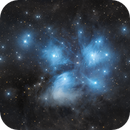Firstly thanks to everyone for the suggestions and advice.
I flocked the spider as per manufacturers advice and got collimation as close as I could.
I got the TS GPU coma corrector. Aside from fixing coma it had the hoped-for effect of pushing out the focus point by 20mm so my draw tube barely intrudes into the OTA at all now.
The only downside I can see so far are some bizarre blue & red blobs that appear to be some sort of internal reflections. I can live with that for now though I think. I can include some images of these artefacts if anyone is interested. They really are quite odd-looking..
Here is the first image I managed since doing the aforementioned alterations.
It’s just 2 hours per panel in a 2-panel mosaic but I’m pretty pleased with it so far.

M45 - Pleiades Mosaic


